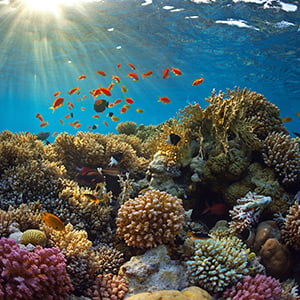
Over-exposure to the sun is one of the leading causes of skin cancer, and the CDC recommends using a sunscreen of at least SPF 15. However, many well-intending consumers are often unaware that their sunscreen can have harmful effects on the environment, notably coral reef bleaching, the process by which coral reefs gradually die from environmental turbulence. This detrimental effect has been linked to chemicals commonly found in sunscreens, like the UV filter oxybenzone, resulting in several bans in Hawaii, Key West, and even REI stores, according to NPR.
According to National Geographic, “14,000 tons of sunscreen are thought to wash into the ocean each year…Even if you don’t swim after applying sunscreen, it can go down drains when you shower. Aerosol versions can spray large amounts of the product onto the sand, where it gets washed into the oceans.” The chemicals from sunscreen have been found in water sources around the world, often missed by common wastewater treatment techniques, meaning they persist in the environment, trapped in plant and animal matter like coral reefs. And although we may feel far from any coral reef here in our landlocked state, all our waters are ultimately connected. Additionally, according to a study published in the International Journal of Environmental Research and Public Health, UV filters like oxybenzone can cause hormone disrupters and reproductive toxicity in fish, and there may be similar disruptions in humans, regardless of proximity to the ocean.
Coral reefs survive by using sunlight to perform photosynthesis, and subsequently provide oxygen for the planet. The “Great Barrier Reef” gets its name because it provides a barrier for the land—protection from storms and erosion. A plethora of food sources and pharmaceutical ingredients are found exclusively in reefs, and reefs provide shelter and habitat for yet another plethora of biodiversity. In short, coral reefs are an integral part of our ecosystem and global economy, and the materials and chemicals going into our oceans are threatening their existence.
Tips for finding a better sunscreen:
1. Sun protection is STILL very important. Although there are significant environmental and health concerns with many mainstream and traditional sunscreens, it is still crucial to protect yourself against the sun, whether through less harmful products, avoiding direct sunlight, or limiting the amount of exposed skin.
2. Pay attention to the ingredient list. There are oxybenzone-free sunscreens that do prevent against some of the most damaging effects to the environment. But while oxybenzone is of concern for ocean habitats, there are other chemicals to avoid as well, according to Consumer Report.
3. Therefore, look for the alternatives. True “reef-safe” sunscreen will be mineral-based and will most likely have a heavy content of zinc. They will also likely be “non-nano,” meaning the ingredients are 100 nanometers in diameter or more and therefore can’t be ingested by corals. There are many different brands and price points available, and a quick google search will provide lots of options.
4. Be smart about labels. “Reef safe” is not a real certification. Anyone can claim it and it doesn’t necessarily mean that it is good for reefs. Reef safe might be friendlier to reefs, but that might be relative. That means it is that much more important to pay attention to the ingredients, and to be aware of what you are putting on your body and into the environment.
William Schmick is a Sustainability Intern with Walking Mountains Science Center. You can see him every Sunday putting zero waste into action at the Vail Farmers Market.
Sources
1. CDC Skin Cancer Prevention
2. Study: Toxicopathological Effects of the Sunscreen UV Filter, Oxybenzone (Benzophenone-3), on Coral Planulae and Cultured Primary Cells and Its Environmental Contamination in Hawaii and the U.S. Virgin Islands
3. NPR: Many Common Sunscreens May Harm Coral. Here's What To Use Instead
4. National Geographic: What sunscreens are best for you and the planet?
5. International Journal of Environmental Research and Public Health
6. Scripps Institute of Oceanography: Value of Corals
7. Consumer Report: The Truth about Reef Safe Sunscreen







